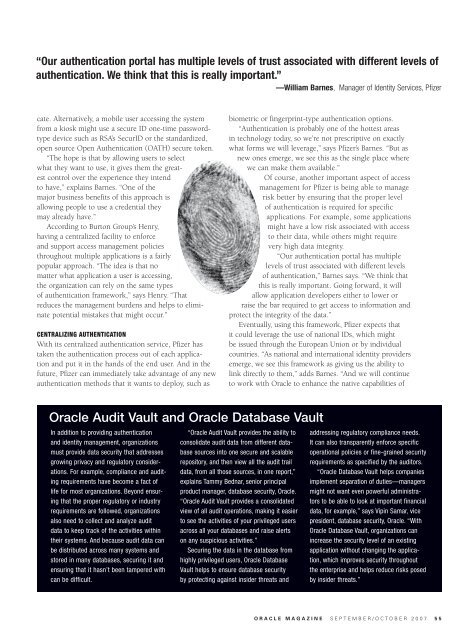Oracle Magazine - September/October 2007 - Marcelo Machado
Oracle Magazine - September/October 2007 - Marcelo Machado
Oracle Magazine - September/October 2007 - Marcelo Machado
You also want an ePaper? Increase the reach of your titles
YUMPU automatically turns print PDFs into web optimized ePapers that Google loves.
“Our authentication portal has multiple levels of trust associated with different levels of<br />
authentication. We think that this is really important.”<br />
—William Barnes, Manager of Identity Services, Pfizer<br />
cate. Alternatively, a mobile user accessing the system<br />
from a kiosk might use a secure ID one-time passwordtype<br />
device such as RSA’s SecurID or the standardized,<br />
open source Open Authentication (OATH) secure token.<br />
“The hope is that by allowing users to select<br />
what they want to use, it gives them the greatest<br />
control over the experience they intend<br />
to have,” explains Barnes. “One of the<br />
major business benefits of this approach is<br />
allowing people to use a credential they<br />
may already have.”<br />
According to Burton Group’s Henry,<br />
having a centralized facility to enforce<br />
and support access management policies<br />
throughout multiple applications is a fairly<br />
popular approach. “The idea is that no<br />
matter what application a user is accessing,<br />
the organization can rely on the same types<br />
of authentication framework,” says Henry. “That<br />
reduces the management burdens and helps to eliminate<br />
potential mistakes that might occur.”<br />
CENTRALIZING AUTHENTICATION<br />
With its centralized authentication service, Pfizer has<br />
taken the authentication process out of each application<br />
and put it in the hands of the end user. And in the<br />
future, Pfizer can immediately take advantage of any new<br />
authentication methods that it wants to deploy, such as<br />
biometric or fingerprint-type authentication options.<br />
“Authentication is probably one of the hottest areas<br />
in technology today, so we’re not prescriptive on exactly<br />
what forms we will leverage,” says Pfizer’s Barnes. “But as<br />
new ones emerge, we see this as the single place where<br />
we can make them available.”<br />
Of course, another important aspect of access<br />
management for Pfizer is being able to manage<br />
risk better by ensuring that the proper level<br />
of authentication is required for specific<br />
applications. For example, some applications<br />
might have a low risk associated with access<br />
to their data, while others might require<br />
very high data integrity.<br />
“Our authentication portal has multiple<br />
levels of trust associated with different levels<br />
of authentication,” Barnes says. “We think that<br />
this is really important. Going forward, it will<br />
allow application developers either to lower or<br />
raise the bar required to get access to information and<br />
protect the integrity of the data.”<br />
Eventually, using this framework, Pfizer expects that<br />
it could leverage the use of national IDs, which might<br />
be issued through the European Union or by individual<br />
countries. “As national and international identity providers<br />
emerge, we see this framework as giving us the ability to<br />
link directly to them,” adds Barnes. “And we will continue<br />
to work with <strong>Oracle</strong> to enhance the native capabilities of<br />
<strong>Oracle</strong> Audit Vault and <strong>Oracle</strong> Database Vault<br />
In addition to providing authentication<br />
and identity management, organizations<br />
must provide data security that addresses<br />
growing privacy and regulatory considerations.<br />
For example, compliance and auditing<br />
requirements have become a fact of<br />
life for most organizations. Beyond ensuring<br />
that the proper regulatory or industry<br />
requirements are followed, organizations<br />
also need to collect and analyze audit<br />
data to keep track of the activities within<br />
their systems. And because audit data can<br />
be distributed across many systems and<br />
stored in many databases, securing it and<br />
ensuring that it hasn’t been tampered with<br />
can be difficult.<br />
“<strong>Oracle</strong> Audit Vault provides the ability to<br />
consolidate audit data from different database<br />
sources into one secure and scalable<br />
repository, and then view all the audit trail<br />
data, from all those sources, in one report,”<br />
explains Tammy Bednar, senior principal<br />
product manager, database security, <strong>Oracle</strong>.<br />
“<strong>Oracle</strong> Audit Vault provides a consolidated<br />
view of all audit operations, making it easier<br />
to see the activities of your privileged users<br />
across all your databases and raise alerts<br />
on any suspicious activities.”<br />
Securing the data in the database from<br />
highly privileged users, <strong>Oracle</strong> Database<br />
Vault helps to ensure database security<br />
by protecting against insider threats and<br />
addressing regulatory compliance needs.<br />
It can also transparently enforce specific<br />
operational policies or fine-grained security<br />
requirements as specified by the auditors.<br />
“<strong>Oracle</strong> Database Vault helps companies<br />
implement separation of duties—managers<br />
might not want even powerful administrators<br />
to be able to look at important financial<br />
data, for example,” says Vipin Samar, vice<br />
president, database security, <strong>Oracle</strong>. “With<br />
<strong>Oracle</strong> Database Vault, organizations can<br />
increase the security level of an existing<br />
application without changing the application,<br />
which improves security throughout<br />
the enterprise and helps reduce risks posed<br />
by insider threats.”<br />
ORACLE MAGAZINE SEPTEMBER/OCTOBER <strong>2007</strong> 55


